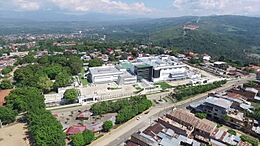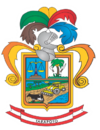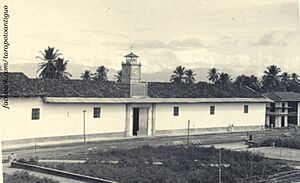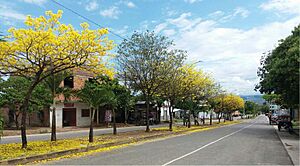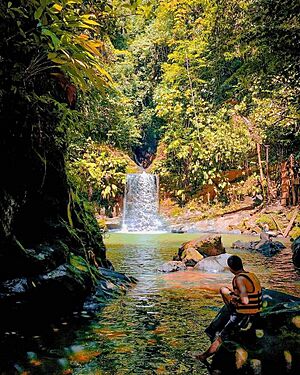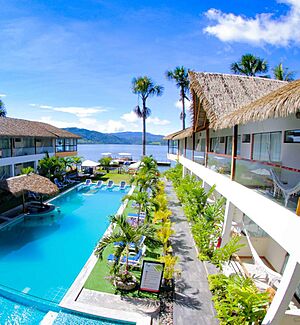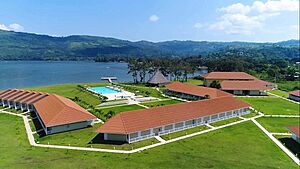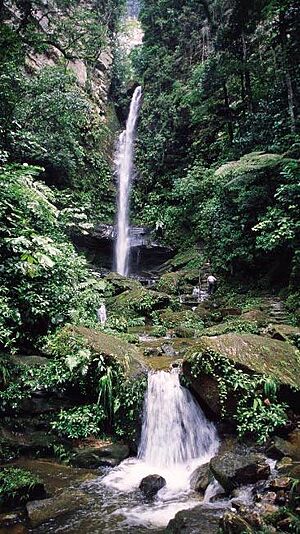Tarapoto facts for kids
Quick facts for kids
Tarapoto
|
|||
|---|---|---|---|
|
Town
|
|||
|
A collage of some places in Tarapoto
|
|||
|
|||
| Nickname(s):
City of Palms
|
|||
| Country | |||
| Region | San Martín | ||
| Province | San Martín | ||
| District | Tarapoto | ||
| Founded | 20 August 1782 | ||
| Area | |||
| • Total | 60.8 km2 (23.5 sq mi) | ||
| Elevation | 356 m (1,168 ft) | ||
| Population
(2020)
|
|||
| • Total | 183,471 | ||
| • Estimate
()
|
223,186 | ||
| • Density | 3,017.6/km2 (7,816/sq mi) | ||
| Demonyms | Tarapotino (a) | ||
Tarapoto is a busy city in the San Martín Province of northern Peru. It is about an hour away from Lima by plane. The city is located in the high jungle area, also known as the cloud forest.
Tarapoto was founded in 1782 by Baltasar Jaime Martínez Compañón. It sits about 356 meters (1,168 feet) above sea level. In 2017, the city had over 180,000 people. If you include nearby areas like Morales and Banda de Shilcayo, the population is over 200,000. This makes Tarapoto the biggest city in its region. It is also the third largest city in the Peruvian Amazon, after Pucallpa and Iquitos. Tarapoto is older than these cities and has more modern services.
Many tourists use Tarapoto as a starting point to explore the huge Amazon Rainforest. The main activities in the area are tourism, trade, and farming. Tarapoto is sometimes called the "City of Palms" because of the many palm trees.
The city is home to the National University of San Martín. This is an important place for learning and getting job skills. Tarapoto has a lively nightlife with many hotels and restaurants. The area is also famous for its beautiful landscapes, waterfalls, and lagoons. These spots are great for adventure tourism, like river rafting and hiking.
Tarapoto is a key place for farm products. The area around the city has many unique plants and animals. These come from where the eastern Andes mountains meet the jungle. This rich nature is perfect for watching birds and enjoying ecotourism.
Today, Tarapoto has modern stores, movie theaters, good hospitals, and fast internet. It also has many hotels and luxury resorts. Roads built in the 1960s helped the city grow a lot. These roads connect Tarapoto to Lima and other major cities like Chiclayo and Trujillo. It also connects to Brazil through the river port of Yurimaguas. From Yurimaguas, boats can reach the Atlantic Ocean using the Huallaga River and the Amazon River.
Contents
History of Tarapoto
Tarapoto was officially founded on August 20, 1782. It was started by the Spanish bishop Baltasar Jaime Martínez Compañón. The city's story began with groups like the Pocras and Chancas. These ancient cultures from the Ayacucho region were conquered by the Inca Empire. They rebelled, but when they lost, they had to escape.
These groups eventually settled in the Mayo and Cumbaza river valleys. This is now the Department of San Martín. They might have first formed the town of Lamas. Later, they created a smaller settlement in the Cumbaza and Shilcayo river valleys. The center of this settlement was the Suchiche Lagoon, which dried up later. Many Taraputus palms grew in this lagoon. The Spanish bishop later used this name when he founded the city in this area. It was a place where people hunted and fished.
The city is located in the valleys of the Cumbaza and Shilcayo rivers. It is a central point for travel and trade between the mountains, the coast, and eastern Peru.
Tarapoto's Geography
Climate and Weather
Tarapoto has a warm, tropical climate. It is a Tropical rainforest climate with steady rainfall all year. However, there is a short dry season from June to September. Temperatures usually range from 21 to 33 degrees Celsius (70 to 91 degrees Fahrenheit). The average yearly temperature is about 25.7 degrees Celsius (78.3 degrees Fahrenheit). Tarapoto gets about 1,162 millimeters (45.7 inches) of rain each year.
Tarapoto has two main seasons. The rainy summer starts in October and ends in June. March and April are the wettest months. During May, the Amazon River, which is near the city, reaches its highest water levels.
Winter brings drier and sunnier weather. June and July are the driest months, but they can still have some rain. Sunny days are common, with high temperatures reaching about 30 to 32 degrees Celsius (86 to 90 degrees Fahrenheit).
| Climate data for Tarapoto, elevation 382 m (1,253 ft), (1991–2020 normals, extremes 1950–present) | |||||||||||||
|---|---|---|---|---|---|---|---|---|---|---|---|---|---|
| Month | Jan | Feb | Mar | Apr | May | Jun | Jul | Aug | Sep | Oct | Nov | Dec | Year |
| Record high °C (°F) | 38.6 (101.5) |
40.0 (104.0) |
38.8 (101.8) |
38.0 (100.4) |
38.0 (100.4) |
36.1 (97.0) |
37.9 (100.2) |
39.2 (102.6) |
40.4 (104.7) |
38.5 (101.3) |
38.3 (100.9) |
38.0 (100.4) |
40.4 (104.7) |
| Mean daily maximum °C (°F) | 32.7 (90.9) |
32.2 (90.0) |
31.8 (89.2) |
31.5 (88.7) |
31.4 (88.5) |
31.0 (87.8) |
31.3 (88.3) |
32.9 (91.2) |
33.3 (91.9) |
33.4 (92.1) |
33.3 (91.9) |
32.8 (91.0) |
32.3 (90.1) |
| Daily mean °C (°F) | 27.9 (82.2) |
27.6 (81.7) |
27.6 (81.7) |
27.4 (81.3) |
27.2 (81.0) |
26.8 (80.2) |
26.5 (79.7) |
27.0 (80.6) |
27.6 (81.7) |
27.9 (82.2) |
28.3 (82.9) |
28.1 (82.6) |
27.5 (81.5) |
| Mean daily minimum °C (°F) | 22.3 (72.1) |
22.1 (71.8) |
21.9 (71.4) |
21.6 (70.9) |
21.4 (70.5) |
20.8 (69.4) |
20.1 (68.2) |
20.4 (68.7) |
21.0 (69.8) |
21.8 (71.2) |
22.3 (72.1) |
22.4 (72.3) |
21.5 (70.7) |
| Record low °C (°F) | 15.0 (59.0) |
15.6 (60.1) |
17.2 (63.0) |
15.0 (59.0) |
12.0 (53.6) |
10.3 (50.5) |
12.0 (53.6) |
12.2 (54.0) |
15.0 (59.0) |
13.9 (57.0) |
13.9 (57.0) |
15.0 (59.0) |
10.3 (50.5) |
| Average precipitation mm (inches) | 136.2 (5.36) |
147.5 (5.81) |
163.0 (6.42) |
160.2 (6.31) |
109.3 (4.30) |
80.0 (3.15) |
68.7 (2.70) |
55.7 (2.19) |
88.5 (3.48) |
112.8 (4.44) |
131.2 (5.17) |
124.5 (4.90) |
1,377.6 (54.23) |
| Source 1: National Meteorology and Hydrology Service of Peru | |||||||||||||
| Source 2: Meteo Climat (record highs and lows) | |||||||||||||
Getting to Tarapoto
By Air
Tarapoto has an airport called Cad. FAP Guillermo del Castillo Paredes Airport. It takes about one hour to fly here from Lima. This airport is very important for travel in the Peruvian rainforest. It has daily flights to and from Lima. It also serves as a stopover for flights to other cities like Iquitos, Pucallpa, and Chiclayo.
By Road
You can reach Lima by bus in about 28 hours. The bus route goes through Moyobamba and Pedro Ruiz. Then it passes through the coastal city of Chiclayo.
Taxis and motorized rickshaws are common and cheap ways to get around Tarapoto. Some intersections can be noisy because of the engines. However, there are efforts to make rickshaws quieter.
Places to Stay in Tarapoto
Tarapoto has many hotels and guesthouses. These are for tourists and business travelers. You can find places to stay both in the city and nearby. There are also some nicer resorts for those looking for more luxury.
Local Culture and Education
Tarapoto is the main cultural center of the San Martín region. It is home to the Universidad Nacional de San Martín. This university offers 15 different study programs. These include Accounting, Engineering, Architecture, Education, Economics, Medicine, and Tourism.
The National University of San Martín also has an important museum. It is called the Museo Regional-UNSM. This museum has interesting collections about the people and history of the Peruvian Amazon.
Other universities also have campuses in Tarapoto. These include the Universidad César Vallejo and the Universidad Peruana Union. There are also many other schools and training centers. For special education, Tarapoto has centers for children with learning difficulties or visual impairments.
Delicious Local Food
Tarapoto is known as the food capital of the Peruvian Amazon. It has a huge variety of delicious dishes. The food mixes flavors from native Amazon cultures, Europe, Japan, and China. Chinese immigrants brought rice to the area a long time ago.
One famous dish is juane. It is made with rice, egg, olive, and chicken. All of this is wrapped in a leaf called bijao. Another popular food is cured pork, especially cecina (dried, smoked pork) and chorizo (sausage). These are now even sold in supermarkets across the country.
The San Martín province, especially Tarapoto, has many unique dishes and drinks. They are famous both in Peru and around the world. This is because of their special ingredients and how they are prepared.
Traditional Dishes
- Juane: This is a traditional dish for the San Juan festivities. It looks like a large tamale. It is made with rice, chicken, and eggs, wrapped in a bijao leaf.
- Ninajuane: Similar to juane, but made with beaten eggs and chicken. It is wrapped in a banana leaf. Both are often cooked on traditional charcoal or firewood stoves.
- Tacacho with cecina: Tacacho is fried and mashed banana mixed with pork fat. It is usually served with cecina (dried, smoked pork). Sometimes it comes with regional chorizo, a seasoned sausage made from ground pork.
- Inchicapi: This is a soup made with ground peanuts, chicken, yucca (cassava), corn, cilantro, garlic, salt, and cumin.
- Patarashca: A traditional jungle food. It uses any type of local fish wrapped in a banana or bijao leaf. It can be roasted, baked, or boiled with spices.
- Timbuche: A soup made with fresh fish, beaten eggs, and cilantro. It is also called the "raise dead" dish because it helps people feel better after a tiring day.
- Meats from the mountains: People in San Martín also eat meat from wild animals. Hunters catch animals like deer, peccary, tapir, armadillo, and picuro. These meats are prepared in many ways, such as roasted, boiled, or in soups.
- Rumo-Api and Sara-Api: These are soups made with wild animal meats. They are served with ground cassava and ground corn, respectively.
Popular Drinks
- Masato: A drink made from cassava. Traditionally, it was chewed and fermented. Today, it is often blended and fermented with yeast.
- Chicha de Maíz: A fermented corn drink. It is mixed with figs and local leaves. In the past, it was used as an alcoholic drink.
- Poroto Shirumbe: A dish made with pork, yucca, and local beans.
- Aguajina: A soft drink made from the aguaje fruit.
- Cocona: A soft drink made from the cocona fruit.
- Chapo: A soft drink made from ripe bananas.
Tarapoto also has many unique alcoholic drinks made from local fruits and roots. Some popular ones include Rompecalzón, Siete Raíces, Uvachado, and Chuchuhuasi.
Fun Tourist Spots Nearby
There are many exciting places to visit near Tarapoto. These include the animal rescue center Urku and the Cumbaza spa. You can also see ancient rock carvings called petroglyphs at Polish (Bello Horizonte). The area has rich plant and animal life.
There are many beautiful waterfalls, such as:
- Ahuashiyacu Falls
- Tamushal
- Pucayaquillo
- Huacamaillo
- Pishurayacu
- Ahuashillo
- Taytayacu
- Union Waterfall
- Toroyacu o Sunipicausani Falls
- Talliquihui
- Sabaloyacu
- Tununtunumba Falls
The Venice Lagoon is another attraction. The largest and most beautiful lake nearby is called Sauce or Laguna Azul (Blue Lagoon).
Visitors can enjoy amazing landscapes with many different plants and animals. There are also chances for adventure tourism. You can go white water rafting on the Mayo River, abseiling, or hiking in the jungle.
Tarapoto is also a way to reach the remote and stunning Rio Abiseo National Park.
|
See also
 In Spanish: Tarapoto para niños
In Spanish: Tarapoto para niños







